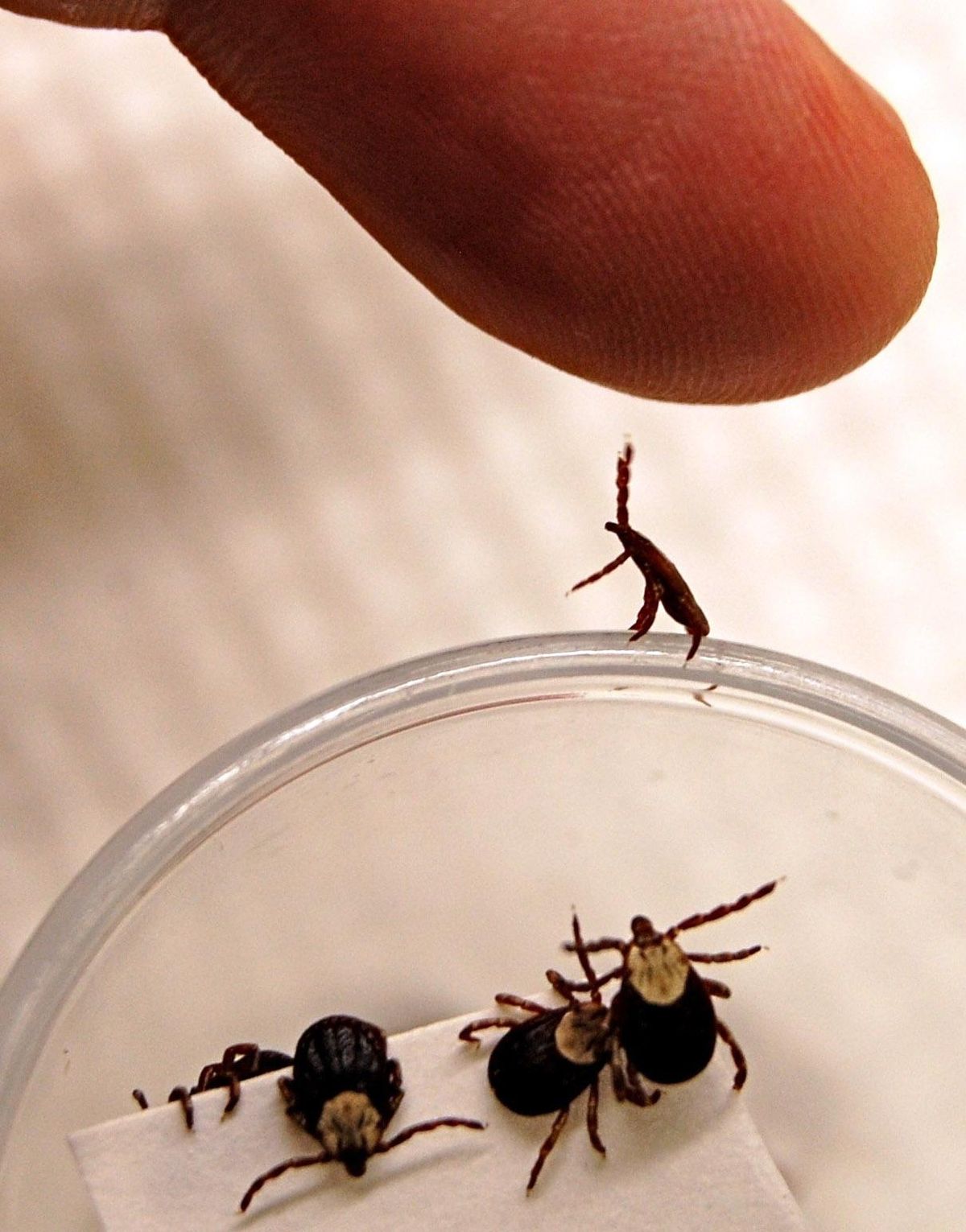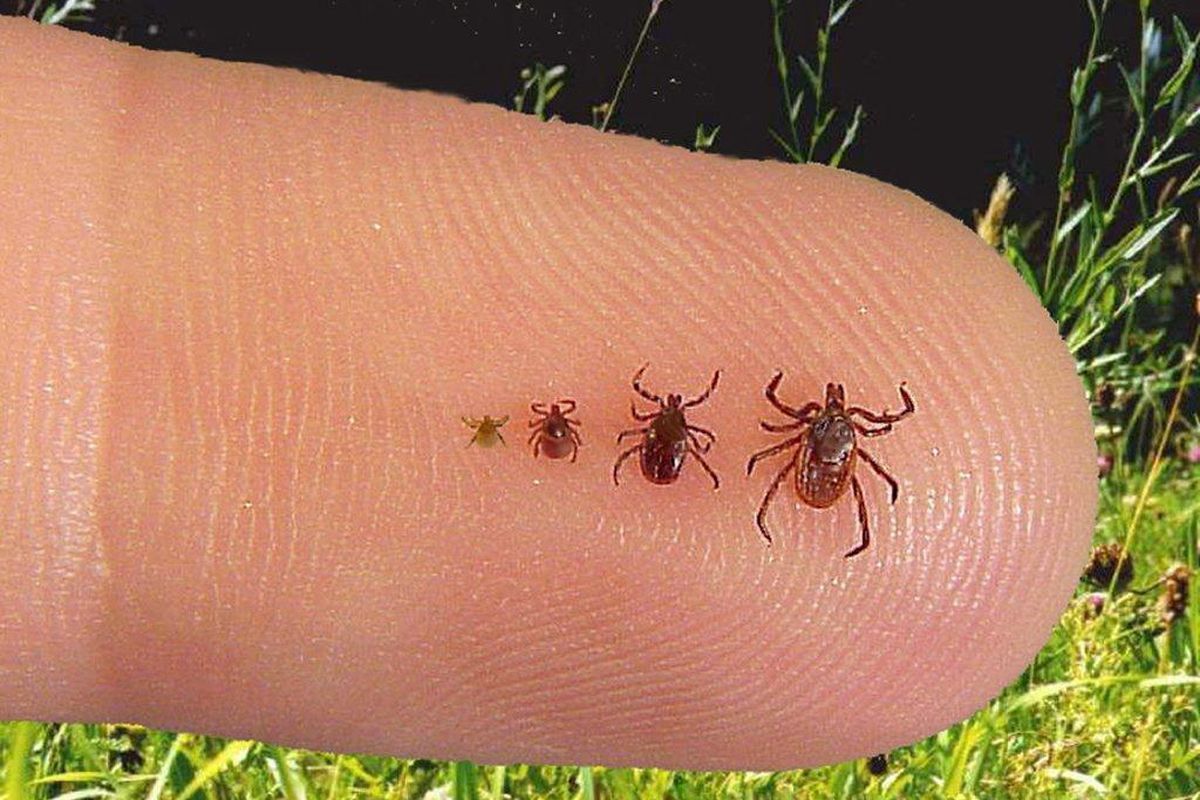Tick-borne diseases rare here, but do occur
A Rocky Mountain wood tick in a lab environment demonstrates its technique for reaching out in nature to latch onto a passing host. (Photo courtesy of Washington State University)
Story corrected to note that soft-shelled ticks are common in the Inland Northwest as vectors of relapsing fever.
Ticks creep out most people, for good reasons.
Aroused by your approach, they’re waiting on ends of grass or other vegetation with legs reaching out for a chance to latch on and scurry for a meal in a quiet spot, such as in the hair on your head or other intimate places.
These arachnids have cutting mouth parts that look like medieval weapons. Left undetected on humans or other animals, they’ll have an orgy in the “quiet place” before slicing into the host’s skin, tapping a capillary, consuming a feast of blood and possibly spitting a disease-carrying pathogen into the host’s bloodstream. Sweet.
An attached tick is remarkably efficient at getting just what it wants, said Jeb Owen, a professor of medical and veterinary entomology at Washington State University.
It separates the fluid from the blood and fills its gut only with red blood cells while expelling the liquid back into the host, he said.
That exchange may in some cases transmit pathogens that can cause diseases.
Most notorious of the tick-borne ailments is Lyme disease. The Centers for Disease Control and Prevention report about 20,000 cases are confirmed annually, mostly in the eastern half of the United States where Ixodes scapularis, the tick mostly associated with the disease, is common.
The Rocky Mountain wood tick that’s common in the Inland Northwest is not known to be a vector for Lyme disease. However, the Ixodes pacifica found in Western Washington can transmit the pathogen, but to a much lesser degree than ticks in the East.
“Zero to three cases of Lyme disease a year are contracted in Washington,” said Owen, an expert in arthropods and the pathogens they transmit to livestock, wildlife and people. “The Department of Health says seven to 12 cases are confirmed in Washington every year, but most are acquired from other parts of the country,” he said.
Those long-odds for contracting Lyme disease are reassuring unless you’re one of the unlucky few people who contract the disease. It can cause debilitating joint pain and other issues.
“Lyme can go undiagnosed because it’s so rare here and its symptoms resemble so many other things,” Owen said.
“A bull’s-eye rash is pretty unique to this infection,” he said. “The problem is that only about 20 percent of the people infected with the bacteria that causes Lyme get a bull’s-eye rash. For instance, they might get just a rash, and lots of things cause rashes.”
Joint pain, fever and other symptoms also are associated with Lyme but not diagnostic, he said.
Meanwhile, the Rocky Mountain wood tick common in this region can cause Rocky Mountain spotted fever.
It’s also been known to cause tick paralysis in people and notably to dogs. The paralysis to part or all of a dog’s body can resolve quickly once the tick is removed.
Most ticks die before bothering people, which is a good thing because there are bazillions of them out there in one stage or another.
“A tick can produce 18,000 larvae from a single batch of eggs, but only about two of them will survive to become adults,” Owen said.
While he makes some generalizations about ticks in educating the public, he notes there are numerous tick species with differing characteristics and behaviors.
The two major families of ticks include the leathery looking hard ticks: the menace associated with most diseases from tick bites. The wrinkled-looking soft-bodied ticks are related especially in this region to relapsing fever, which, as the name implies, can come, go, and recur again.
The vectors of tick-borne relapsing fever in the Western U.S. are members of the tick genus Ornithodoros, soft-shelled and widespread in the Inland Northwest. These ticks are genetically related to the Lyme disease spirochete. Numerous multiple and single cases of relapsing fever have been reported in this region, health department officials say, noting that sometimes the cases have been misdiagnosed as Lyme disease.
Tick larvae could fit within the margins of the letter ‘o’ on this page, Owen said. Nymphs, the next stage, are bigger and adult ticks can be half the size of a watermelon seed.
But they all need to dine on a blood meal and drop off a host in order to progress to their next stage.
The larvae and nymphs feed mostly on rodents, especially white-footed mice, while the adults are more likely to feed on larger game, including humans.
If a tick doesn’t find a host, it can endure a winter or two or three and keep trying. Tick numbers can be thinned out in the environment by an unusually hot summer as well as a dry winter with prolonged exposure to cold without a snow cover, Owen said.
The most common adult tick host likely is the white-tailed deer – prolific across much of the country especially since numbers boomed in the 20th century.
Ticks feed exclusively on blood, which fuels their growth and reproduction.
While 90 percent of a tick’s life cycle is on the ground, it’s that need for another meal that catches our attention, whether it’s on our dog, the deer we harvest in fall or on ourselves.
A tick is most likely to survive on an animal around the host’s head or under its tail where it can’t be groomed off by licking or pawing.
The host is a buffet as well as a bedroom for the adult ticks. The female attaches and releases pheromones that lure the male through the hair looking for her. Depending on the tick species, they’ll copulate and then feed. The male will take just a snack before moving on for another mate.
The female will feed grotesquely, engorging herself to blimp-like proportions before dropping off. Stuffed with red blood cells, her legs may not touch the ground, forcing the tick to produce her beau coup crop of eggs pretty much right where she landed.
“This is why the most common place to pick up a tick is along a game trail where the ticks are falling off deer,” Owen said.
Ticks look for hosts primarily in spring, also early fall. If they don’t find a host, they wait until the next spring.
That’s the good news. The worst of the Rocky Mountain wood tick “season” is winding down, with the peak of feeding activity in April through June. Consequently, the peak of symptoms related to tick diseases stretches through July, although symptoms may not occur for a year, Owen said.
The less than good news, he said, is that some tick larvae, nymphs and adults are out there feeding on something nearly anytime.

